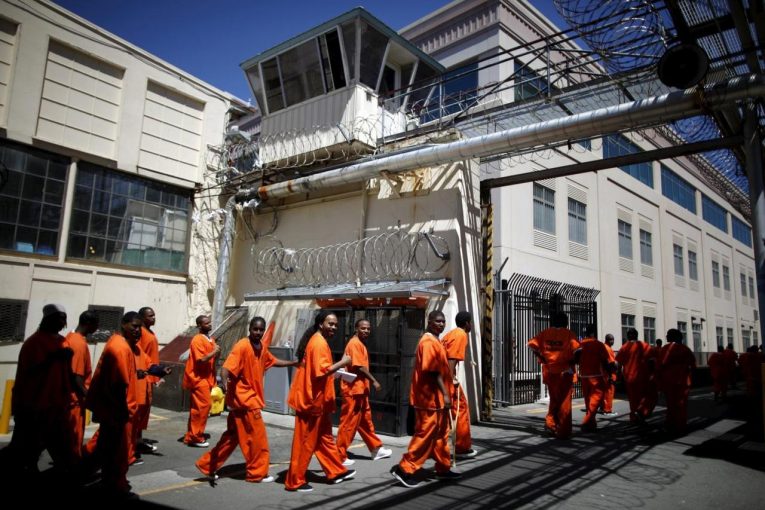
By Julietta Bisharyan and Nick Gardner
CDCR Confirmed COVID-19 Cases and Outcomes
As of Aug. 28, there are a total of 10,377 confirmed COVID-19 cases in the CDCR system – 859 of them emerged in the last two weeks. 10.6% of the cases are active in custody while 3.2% have been released while active. Roughly 85.6% of confirmed cases have been resolved.
There have been 57 deaths across the CDCR system thus far and two this week at CA Institution for Men (CIM) in Chino and at San Quentin State Prison (SQ).
Nearly all of Chuckawalla Valley State Prison’s (CVSP) cases have been resolved –– 1,035 of 1,054. CVSP, however, has only tested 5% of its population –– the second least amount of tests administered in the past two weeks.
This week, CDCR and its health care services agency announced that intake will resume in a controlled, limited manner, after being suspended beginning the week of Aug. 24. Intake will be prioritized for counties extremely limited on jail space.
“CDCR recognizes the burden placed upon counties housing individuals in local facilities after sentencing, and the burden placed on those individuals and their loved ones in these times of great uncertainty,” the department said in a statement.
This decision, however, is not expected to have an immediate impact on the population of Pelican Bay State Prison (PBSP) in Del Norte County.
Intake will begin with testing, symptom screening, and the transfer of 50 individuals from San Joaquin County and 50 from Kings County. Intake will only be accepted at North Kern State Prison and Wasco State Prison Reception Centers.
CDCR will continuously evaluate this process and will increase, decrease, or suspend intake in accordance with health care and public health guidance.
For those newly released from state prison, California’s “Project Hope” program offers free hotel accommodations to individuals who need to be quarantined or need to isolate themselves due to COVID-19 exposure or positive status.
Stanislaus County officials confirmed that at least eight incarcerated persons were held at the Candlewood Suites in Turlock as part of “Project Hope.“
Mark Ferriera, chief probation officer for Stanislaus County said individuals on Post Release Community Supervision (PRCS) are supervised by the county while, generally, those who committed serious or violent offenses are overseen by State Parole.
Ferriera said the county was not involved in the program and did not have any involvement in developing a contract with the Candlewood Suites. The county also didn’t have information on the number of incarcerated individuals placed at the hotel on state parole.
According to CDCR, there are currently 95,491 incarcerated persons in California’s prisons –– a reduction of 19,159 since Mar. 12, 2020.
COVID-19 in CDCR’s San Quentin
For the first time in two months, San Quentin State Prison reports less than 50 active cases –– currently at 20. There have been zero new cases in the last two weeks.
On Wednesday, San Quentin News, the award-winning newspaper run by a staff of incarcerated and formerly incarcerated journalists at SQ, announced that it has resumed monthly publication and distribution following a six-month hiatus due to the pandemic.
The newspaper reports on rehabilitative efforts to increase public safety and achieve social justice inside the prison.
“I had the privilege to work for the San Quentin News while incarcerated at San Quentin. Since being released on May 1, I am honored to still contribute to the newspaper,” said Jonathan Chiu, the former San Quentin News layout editor and crossword creator. “While my incarcerated family is not able to continue our mission of rehabilitation through prison journalism during the pandemic, our entire formerly incarcerated news staff is excited to assist and keep SQ’s mission of advancing social justice.”
The relaunch was made possible by support from CDCR as well as a $75,000 grant from the Chan Zuckerberg Initiative to Friends of San Quentin News. The grant will also be used to establish an external fellowship program allowing formerly incarcerated staff members to continue to support the San Quentin News following their release.
Before the pandemic, the newspaper circulated across the entire network of California state prisons supported by multi-year grants from the Reva and David Logan Foundation and approximately 300 individual donors.
“It [San Quentin News] has grown beyond the walls of the prison, and it took a global pandemic to bring it to a pause. However, those who were within the walls and are now alumni newspaper men, have come back to continue to give a voice to the men inside. The San Quentin News lives,” said Lt. Sam Robinson, public information officer for San Quentin State Prison.
CDCR Staff
There are currently 2,765 staff cases in CDCR facilities. 1,247 are currently active and 1,518 have returned to work.
San Quentin makes up 10% of the total staff cases.
Effect of CDCR Outbreaks on the Public
Nearly 6,000 incarcerated Californians have been released as a result of the state’s effort to control COVID-19 in prisons. Among them is Timothy Alan Ray, a 65 year-old Fresno resident convicted of using racial slurs against a black man while threatening to kill him with a sword.
Ray was sentenced in January 2016 to 10 years in prison on charges of criminal threats and carrying a concealed knife. In December of that year, Ray requested a hearing before a parole board who denied his early release, deeming him an “unreasonable risk of violence.”
News of Ray’s release outraged Fresno County District Attorney Lisa Smittcamp, who believed the decision to be a “miscarriage of justice.”
“The Fresno County District Attorney’s Office firmly believes that nothing has changed and that Mr. Ray continues to pose a threat to public safety and that his early release constitutes a gross miscarriage of justice,” Smittencamp told the Fresno Bee.
CDCR spokesperson Luis Patiño Jr. affirmed that Ray’s release was a part of the CDCR’s efforts to reduce prison population by releasing those with less than 180 days on their sentence. Patiño explained how Ray, who was convicted of criminal threat to cause great bodily injury, carrying a concealed weapon, a dagger, and an enhancement for having a prior felony was eligible for release due to his time-served, work, meritorious, and goodtime credits.
Unfortunately for Andrew Janz, the prosecutor in Ray’s case, he was tasked with informing the victim, 56 year-old Charles Roberts, of the CDCR’s decision.
“As a prosecutor, I hate having to go back to tell a victim that his attacker will be escaping justice,” said Janz. “This decision by the Department of Corrections seems to have been made without regard for its impact on Mr. Roberts.”
Although uninjured, Roberts still recalls the fear of seeing Ray, an army veteran, approach him with a sword and knife while yelling racial slurs.
“I didn’t even know the guy, but all of sudden I see this guy with a big trench coat looking at me and then he opens his jacket and pulls out this sword and knife,” said Roberts. “Once he did that I thought holy smokes, I got to get out of there.”
At Ray’s trial, it took the jury only 20 minutes to find him guilty despite pleas of post-traumatic stress disorder alongside alcohol and drug addictions.
Judge Arlan Harell justified the 10 year prison sentence given Ray’s criminal history and status as a danger to society. Ray’s criminal history extends as far back as 40 years, and includes convictions for robbery, possession of drugs and drug paraphernalia, and three separate convictions for driving under the influence.
Roberts agrees with the court’s assessment of Ray as a danger to society, and when asked, expressed concern over his release.
“I’m not scared, I will protect myself if I have to protect myself,” Roberts said. “I just don’t want him to hurt somebody else, but I have a feeling that is what’s going to happen.”
The family of Cara Knott is petitioning California Governor Gavin Newsom to prevent a possible early release for Craig Peyer.
In 1986, Peyer, a California Highway Patrol Officer, pulled over 20 year old Cara Knott on Interstate 15 in the Rancho Penasquitos area. A conflict broke out after Knott threatened to report the officer for making inappropriate advances.
During this conflict, Peyer, who had a history of pulling over young female drivers, was scratched in the face by Knott. The officer then removed Knott from the car and bludgeoned her in the face with his flashlight before strangling her to death with a rope. Peyer threw Knott’s body off of an abandoned bridge before fleeing the scene.
Peyer isn’t set for review before a parole board until 2027, however the family of Cara Knott has learned that people incarcerated at the California Men’s Colony — where Peyer is serving his sentence — have been released early due to the pandemic.
In the family’s letter to Governor Newsom, Knott’s sister argued against releasing Peyer out of concern for his health.
“This is precisely NOT a person who deserves to be released early from prison for humanitarian reasons. Officer Peyer showed NO Mercy when he murdered my sister.”
As for the family’s concerns, the possibility of an early release for Peyer may not even be on the table.
Peyer has gone before the parole board at the California Men’s Colony twice before in 2008 and 2012, and both times his request was denied. On the latter occasion the former officer was deemed eligible for review only after 15 years — the longest time allowed under state law.
The San Diego District Attorney’s Office announced on Tuesday that it will be forming a team to notify crime victims if incarcerated people related to their case are released early due to COVID-19 mitigation efforts.
So far, thousands of incarcerated Californians have been released early in a statewide effort to ensure better social distancing environments within prisons. Those eligible for expedited release include incarcerated individuals with less than a year left on their sentence or pre-existing health conditions that elevates their risk of contracting the respiratory virus.
The San Diego District Attorney’s Office has already received hundreds of notifications from the CDCR concerning early releases thus far. However, the CDCR is only sending out notifications to those registered in its victim notification system.
The DA’s new team will attempt to notify those not registered in the CDCR’s system, as well as provide them with resources such as counseling and action towards obtaining a restraining order.
When questioned by the Times of San Diego, the District Attorney’s Office expressed concern over the CDCR’s early release program, and specifically those eligible to qualify.
“We were very concerned that with CDCR focused on reducing the prison population due to the pandemic, victims were not getting any opportunity to be heard in this process, nor was CDCR notifying victims so they can take steps to provide for their safety,” said District Attorney Summer Stephan. “While many of the inmates being released were already nearing the end of their terms, CDCR is also releasing inmates who were sentenced to life terms for very serious offenses.”
Through the creation of her new team, Stephan is already helping inform victims of early releases for incarcerated individuals connected to their case.
We requested notice before San Diego releases began taking place, and we were able to get assurances in that regard. CDCR is now sending out expedited release notices to our office and our team is working quickly to notify affected victims whom we are able to locate in the short notice we will have and provide any needed resources.”
Due to the CDCR’s statewide early release program in response to the COVID-19 crisis, hundreds of incarcerated people will no longer be available to offer their services during a record wildfire season in California.
The early release program— aimed around improving state prisons’ ability to social distance— has already seen to the release of nearly 6,000 incarcerated Californians. Among those individuals are around 600 incarcerated firefighters, described by Cal Fire Resource Management Communications Officer Christine McMorrow as “an integral part of our firefighting operations.”
Each year, these incarcerated individuals team up alongside Cal Fire to suppress wildfires that plague the state typically between the months of May and October. These individuals often times act as “hand crews,” and are tasked with creating fire lines through the use of shovels, rakes and axes.
However, as more incarcerated individuals are released from the CDCR system, Cal Fire will need to allocate valuable time and resources towards staffing hand crews.
Each incarcerated fire crew consists of around 12 to 17 people. Currently there are 102 crews actively fighting the LNU and SCU lightning complex fires, totaling 1,306 individuals.
During the 2019 wildfire season,1,865 of the nearly 3,000 incarcerated individuals housed in conservation camps were firefighters. This year, the conservation camp population has declined significantly, and with it the number of incarcerated firefighters, which of this August amounts to 1,659 individuals.
Per usual, these “minimum custody” volunteers will earn on average $3.63 per day, plus a potential $1.00 bonus if they are deployed to an active fire. Furthermore, upon completing their sentences, many of these individuals will be barred from firefighting careers due to their status as convicted felons.
As of now, Governor Gavin Newsom has confirmed that 100 percent of the state’s firefighting resources have been deployed to the two major lightning-based fires.
Newsom has also requested additional support from Arizona, Nevada, and Texas.
CDCR Comparisons – California and the US
According to the Marshall Project, California prisons rank fourth in the country for the highest number of confirmed cases, following Texas, Florida and Federal prisons. California makes up 9.4% of total cases among incarcerated people and 6% of the total deaths in prison.
There have been at least 2,718 cases of coronavirus reported among prison staff. 9 staff members have died while 1,472 have recovered.
Division of Juvenile Justice
As of Aug. 28, there are no active case of COVID-19 among youth at DJJ facilities, and 68 are resolved.




